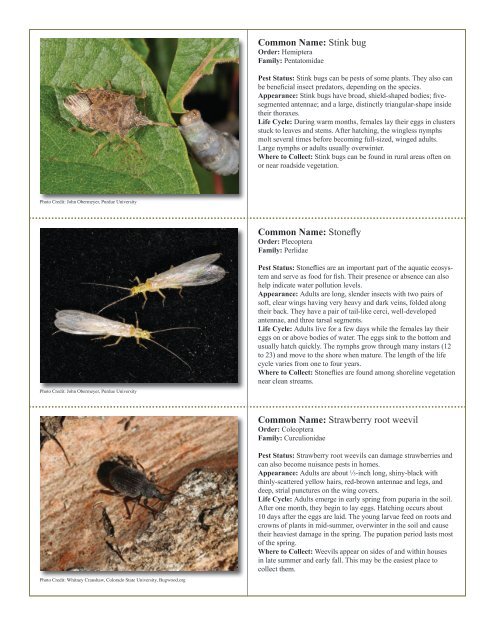to download pdf - Purdue Extension Entomology - Purdue University
to download pdf - Purdue Extension Entomology - Purdue University
to download pdf - Purdue Extension Entomology - Purdue University
Create successful ePaper yourself
Turn your PDF publications into a flip-book with our unique Google optimized e-Paper software.
Common Name: Stink bug<br />
Order: Hemiptera<br />
Family: Penta<strong>to</strong>midae<br />
Pest Status: Stink bugs can be pests of some plants. They also can<br />
be beneficial insect preda<strong>to</strong>rs, depending on the species.<br />
Appearance: Stink bugs have broad, shield-shaped bodies; fivesegmented<br />
antennae; and a large, distinctly triangular-shape inside<br />
their thoraxes.<br />
Life Cycle: During warm months, females lay their eggs in clusters<br />
stuck <strong>to</strong> leaves and stems. After hatching, the wingless nymphs<br />
molt several times before becoming full-sized, winged adults.<br />
Large nymphs or adults usually overwinter.<br />
Where <strong>to</strong> Collect: Stink bugs can be found in rural areas often on<br />
or near roadside vegetation.<br />
Pho<strong>to</strong> Credit: John Obermeyer, <strong>Purdue</strong> <strong>University</strong><br />
Common Name: S<strong>to</strong>nefly<br />
Order: Plecoptera<br />
Family: Perlidae<br />
Pho<strong>to</strong> Credit: John Obermeyer, <strong>Purdue</strong> <strong>University</strong><br />
Pest Status: S<strong>to</strong>neflies are an important part of the aquatic ecosystem<br />
and serve as food for fish. Their presence or absence can also<br />
help indicate water pollution levels.<br />
Appearance: Adults are long, slender insects with two pairs of<br />
soft, clear wings having very heavy and dark veins, folded along<br />
their back. They have a pair of tail-like cerci, well-developed<br />
antennae, and three tarsal segments.<br />
Life Cycle: Adults live for a few days while the females lay their<br />
eggs on or above bodies of water. The eggs sink <strong>to</strong> the bot<strong>to</strong>m and<br />
usually hatch quickly. The nymphs grow through many instars (12<br />
<strong>to</strong> 23) and move <strong>to</strong> the shore when mature. The length of the life<br />
cycle varies from one <strong>to</strong> four years.<br />
Where <strong>to</strong> Collect: S<strong>to</strong>neflies are found among shoreline vegetation<br />
near clean streams.<br />
Common Name: Strawberry root weevil<br />
Order: Coleoptera<br />
Family: Curculionidae<br />
Pest Status: Strawberry root weevils can damage strawberries and<br />
can also become nuisance pests in homes.<br />
Appearance: Adults are about 1 ⁄5-inch long, shiny-black with<br />
thinly-scattered yellow hairs, red-brown antennae and legs, and<br />
deep, strial punctures on the wing covers.<br />
Life Cycle: Adults emerge in early spring from puparia in the soil.<br />
After one month, they begin <strong>to</strong> lay eggs. Hatching occurs about<br />
10 days after the eggs are laid. The young larvae feed on roots and<br />
crowns of plants in mid-summer, overwinter in the soil and cause<br />
their heaviest damage in the spring. The pupation period lasts most<br />
of the spring.<br />
Where <strong>to</strong> Collect: Weevils appear on sides of and within houses<br />
in late summer and early fall. This may be the easiest place <strong>to</strong><br />
collect them.<br />
Pho<strong>to</strong> Credit: Whitney Cranshaw, Colorado State <strong>University</strong>, Bugwood.org
















